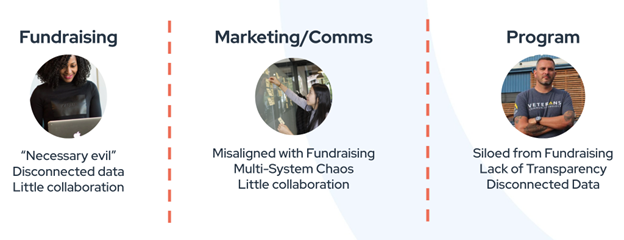 By Gabe Cooper, CEO of Virtuous
By Gabe Cooper, CEO of VirtuousIf you’ve been around nonprofits for any length of time you’ve inevitably heard a nonprofit leader say “Donors are a relationship, not a transaction” – or possibly even “Our donors are more than just checkbooks.” Nonprofit leaders intuitively know that their constituents have far more to give than just money.
Your own personal experiences working with nonprofits likely validate this concept. Our motivations, level of involvement and advocacy around a cause stretch far beyond our checkbook. The community surrounding a nonprofit is made up of individual “whole” people with a unique blend of time, talent, assets and social capital to bring to the table.
Unfortunately, even though most nonprofits recognize this reality, the systems in place within the walls of the organization inhibit a more holistic view of their constituents. The Marketing/Comms, Program, Fundraising and Volunteer/Activism teams often have siloed conservations with constituents that are disconnected from other departments. Fundraising focuses on getting a check, volunteer coordinators focus on volunteer time, and Marketing focuses on telling the story – and the person on the receiving end of these communications feels pulled in multiple directions from a disjointed approach to generosity.
In order to break down these silos it’s imperative that nonprofits take intentional steps toward viewing their constituents as whole people. With that in mind, we often recommend two key focus areas to better align nonprofit teams around a more holistic view of generosity.
Key Focus 1 : Removing Team & Data Silos
As we’ve worked with nonprofit teams we’ve commonly discovered significant walls between both teams and nonprofit data sources. For example:
- The Program team views Fundraising as a “necessary evil” and provides little collaboration or insights into program outcomes.
- The Marketing teams purchase software tools that are completely disconnected from fundraising data.
- The Volunteer team works closely with Program but isn’t connected to broader fundraising goals.
In this model, constituent insights become more opaque and silos are hardened.

The Power of Generosity Ops
One strategy that we’ve found to be particularly effective in removing these walls is the formation of a Generosity Ops team. Rather than focusing on traditional Fundraising Operations, the Generosity Ops team sits outside of the other departments and becomes a broker of shared data insights and learnings across the organization.
Like Data Ops or Revenue Ops in the for-profit world, Generosity Ops is the steward of organizational data and collaboration. They connect the dots between the teams and surface opportunities to build more holistic relationships with constituents.
A few examples of the kind of work produced by a Generosity Ops team might include:
- Ensuring that volunteer data is connected to donor data to better understand each person holistically
- Ensuring that program impact data/stories are tagged appropriately and surfaced to fundraising/marketing so that each individual is connected to the impact they are most interested in.
- Ensuring that potential ambassadors/activists are identified early through social media, engagement or event data – and then matched with opportunities that fit their super powers.
It’s often difficult for smaller nonprofits to stand up a full Generosity Ops team, but sometimes even a single person or committee can have dramatic short-term impact in streamlining constituent experience.
For larger nonprofits, the Generosity Ops teams would often include a data scientist and a strategist working together to connect systems and find ways to increase collaboration across teams.
Key Focus 2 : Aligning Metrics
Once data and team silos are removed, it’s important that nonprofit teams align around a common set of metrics that focus on a more holistic view of generosity. Rather than pursuing isolated, team-specific metrics, healthy organizations roll up team KPIs to a shared set of organizational goals.
In a perfect world:
- The Volunteer team owns a portion of the fundraising goal
- The Fundraising team is responsible for surfacing potential volunteers or advocates
- The Program team knows how their impact data is driving marketing and fundraising metrics
- The Program and Comms teams are calling volunteers or donors monthly in order to learn
Most successful organizations drive KPI alignment by using a common goal setting framework like OKRs (Objectives and Key Results) or Rocks (EOS Framework). The Executive team works together to create annual and quarterly goals for generosity across multiple vectors (Volunteerism, Activism, Financial Giving, Retention, Engagement, etc.). Then each individual team participates in quarterly Rock/OKR planning to ensure every member of the team knows how their daily job impacts the organizational goals for generosity.
Once quarterly goals are set, goals are shared broadly across the organization. If you’ve launched a Generosity Ops team, then this team becomes responsible for helping track and share progress toward goals across the various departments. This level of goal transparency creates both team alignment and accountability around a metrics-driven approach to holistic generosity.
The Potential of Holistic Generosity
While the details of your metrics or team structure may seem far removed from the personal, emotional reasons people give, they have a tremendous impact on the kind of donor experiences your team will be able to create.
When you use aligned technology and systems across the organization to offer supporters personalized, cohesive experiences, your donors, volunteers, influencers and advocates will experience a “whole person” approach to every interaction, and you will ultimately move beyond transactions into lasting relationships.


